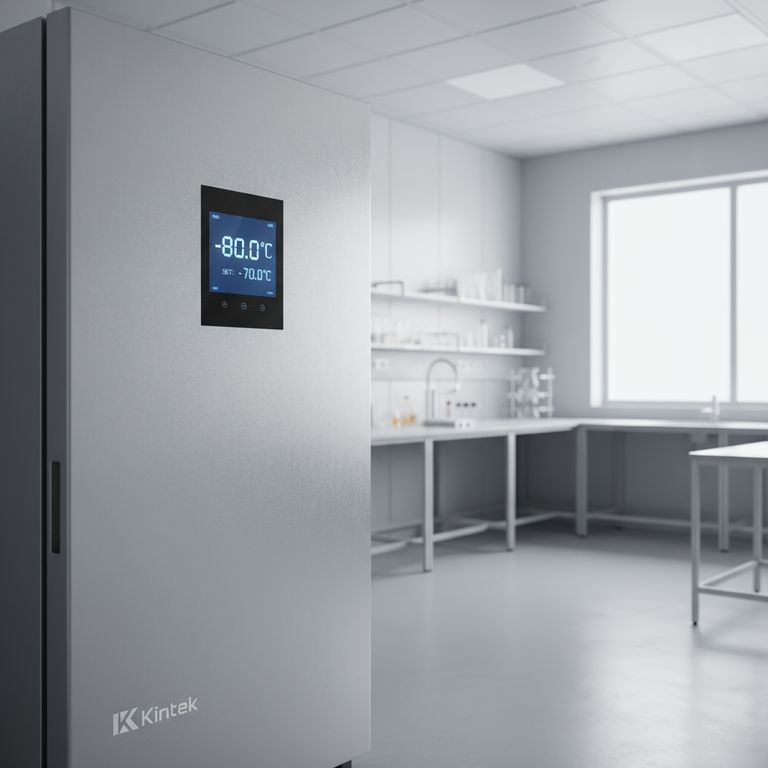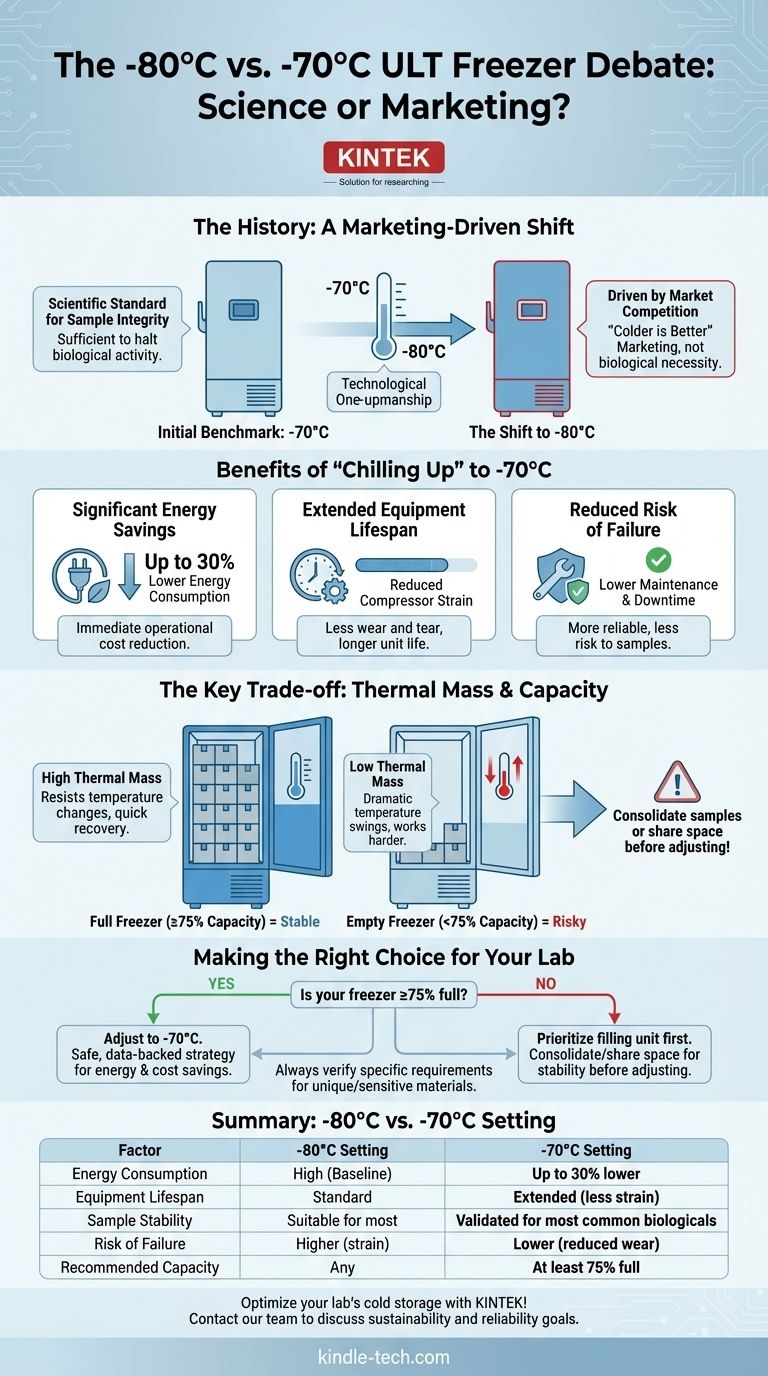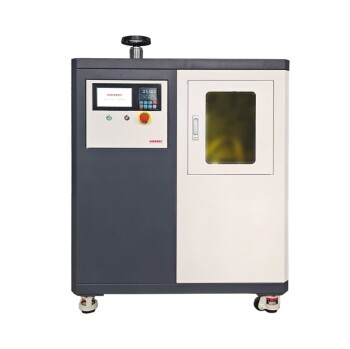The standard for ultra-low temperature (ULT) freezers was not originally -80°C. In fact, the initial benchmark was -70°C. The shift to -80°C appears to be a historical artifact driven by manufacturer marketing rather than a distinct scientific requirement for the majority of biological samples.
The widespread adoption of -80°C is largely a remnant of market competition, not a mandate of biological science. For most labs, adjusting the setpoint to -70°C is a safe, validated strategy that significantly reduces energy consumption and extends the life of the freezer.

The Origins of the -80°C "Standard"
To understand the current norm, we must look at the history of the equipment itself. The -80°C setpoint is less about scientific necessity and more about technological one-upmanship.
The Initial Benchmark: -70°C
Early ULT freezers were engineered to reliably maintain temperatures of -70°C. This temperature was sufficient to halt biological activity and preserve the integrity of most common samples like DNA, RNA, and proteins.
The Influence of Marketing
In a competitive market, manufacturers sought ways to differentiate their products. Pushing for a lower temperature—from -70°C to -80°C and even lower—became a proxy for superior engineering and performance.
Labs began to adopt -80°C as the default, assuming "colder is better," an assumption that has since been proven unnecessary for most applications. There is no significant body of scientific evidence demonstrating a clear advantage of -80°C over -70°C for general sample preservation.
The Real-World Impact of -70°C vs. -80°C
Moving a freezer's setpoint by 10 degrees may seem minor, but its practical consequences are substantial. This single change directly impacts energy costs, equipment reliability, and your lab's carbon footprint.
Significant Energy Savings
Adjusting a ULT freezer's setpoint from -80°C to -70°C can reduce energy consumption by up to 30%. This translates into immediate and significant operational cost savings.
Extended Equipment Lifespan
Maintaining -80°C places immense strain on a freezer's compressors. By easing this workload, a -70°C setpoint reduces wear and tear, leading to a longer operational life for the unit.
Reduced Risk of Failure
A less-strained freezer is a more reliable freezer. Prolonging the life of the components means less downtime for maintenance and a lower risk of catastrophic failure, which is the single greatest threat to your samples.
Understanding the Key Trade-off: Freezer Capacity
While a -70°C setpoint is overwhelmingly beneficial, there is one critical factor to consider before making the change: how full the freezer is.
The Critical Factor: Thermal Mass
The contents of your freezer act as a thermal battery. A freezer packed with frozen boxes and samples has a high thermal mass, meaning it can absorb heat and resist temperature changes.
Why a Full Freezer is More Stable
When you open the door of a full freezer, the cold mass of the samples helps maintain the internal temperature. The unit recovers to its setpoint much more quickly after the door is closed.
The Risk of an Empty Freezer
In a partially full freezer, there is more air and less thermal mass. Opening the door causes a much more dramatic temperature swing, and the unit must work harder and longer to return to its setpoint. This effect is more pronounced at -70°C than at -80°C.
If your freezer is not full, it is highly advisable to consolidate samples or share space with another lab to ensure it is at least 75% full before adjusting the temperature.
Making the Right Choice for Your Lab
The decision to "chill up" to -70°C is a powerful way to improve lab sustainability and reduce costs without compromising sample safety. Your decision should be based on your specific storage conditions.
- If your primary focus is energy efficiency with a full freezer: Adjusting your setpoint to -70°C is a safe, data-backed strategy to immediately lower costs and equipment strain.
- If your freezer is consistently less than 75% full: Prioritize filling the unit by consolidating samples or sharing space before you adjust the temperature to ensure stability.
- If you store unique or exceptionally sensitive materials: Always verify the specific storage requirements from the supplier, but recognize that -70°C is the validated standard for the vast majority of common biologicals.
By understanding the history and the science, you can make an informed decision that optimizes your cold storage strategy for both long-term sample safety and operational efficiency.
Summary Table:
| Factor | -80°C Setting | -70°C Setting |
|---|---|---|
| Energy Consumption | High (Baseline) | Up to 30% lower |
| Equipment Lifespan | Standard | Extended (less strain) |
| Sample Stability | Suitable for most samples | Validated for most common biologicals |
| Risk of Failure | Higher due to compressor strain | Lower with reduced wear |
| Recommended Freezer Capacity | Any | At least 75% full for thermal mass |
Optimize your lab's cold storage strategy with KINTEK! As specialists in lab equipment and consumables, we understand the critical balance between sample integrity and operational efficiency. Whether you're consolidating ULT freezers or seeking energy-efficient solutions for your laboratory, our expertise ensures your samples are safe while you save on costs. Contact our team today to discuss how we can support your lab's sustainability and reliability goals.
Visual Guide

Related Products
- 508L Advanced Vertical Ultra Low Temperature Freezer for Critical Laboratory Storage
- 408L Advanced Vertical Laboratory Ultra Low Temperature Freezer for Critical Research Material Preservation
- 58L Precision Laboratory Ultra Low Temperature Upright Freezer for Critical Sample Storage
- 158L Precision Vertical Ultra Low Freezer for Laboratory Applications
- 808L Precision Laboratory Vertical Ultra Low Temperature Freezer
People Also Ask
- What advantages do ultra-low temperature freezers offer? Ensure Long-Term Sample Integrity and Reliability
- What temperature range do Ultra-Low Temperature freezers maintain? The -80°C Standard for Sample Integrity
- What is the price range for ultra low temperature freezers? Protect Your Samples with the Right Investment
- What makes Ultra-Low Temperature freezers energy efficient? Key Design & Operational Strategies
- Where are ultra low temperature freezers commonly used? Essential for Labs, Hospitals, and Biotech



















